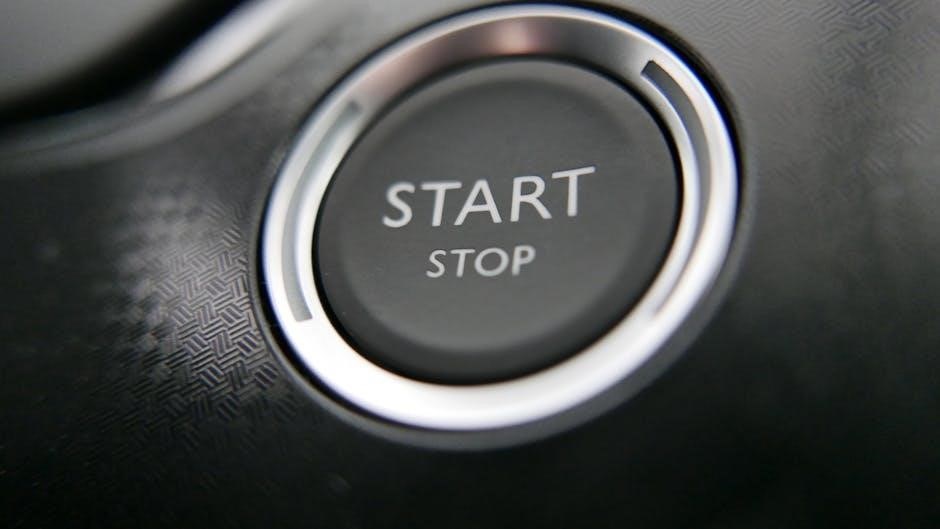The Circle of Control is a powerful concept helping individuals identify factors they can directly influence, indirectly impact, or cannot control, fostering empowerment and reducing stress․
1․1 Definition and Purpose
The Circle of Control is a practical tool designed to help individuals distinguish between factors they can directly influence, those they can indirectly impact, and those beyond their control․ Its purpose is to empower people by focusing their energy on manageable aspects of life, reducing stress and anxiety caused by uncontrollable events․ By categorizing concerns into three circles—Control, Influence, and Concern—it provides clarity and encourages intentional decision-making, fostering resilience and emotional well-being․
1․2 Importance of the Concept in Modern Life
The Circle of Control is a vital tool in today’s fast-paced, unpredictable world, offering a clear framework to manage stress and regain focus․ By distinguishing controllable factors from uncontrollable ones, individuals can reduce anxiety and channel their energy into meaningful actions․ This concept is particularly valuable for fostering mental well-being, improving decision-making, and enhancing resilience in the face of life’s challenges․
Its relevance extends across personal and professional realms, empowering individuals to prioritize effectively and maintain a sense of control amidst uncertainty․ Regular application of this concept promotes emotional balance and long-term success, making it indispensable in modern life․

Origin and Development of the Circle of Control
The Circle of Control concept was popularized by Stephen Covey, who introduced the three-circle model: Control, Influence, and Concern․ Its evolution emphasizes focusing on controllable factors․
2․1 History and Key Contributors
The Circle of Control concept gained prominence through Stephen Covey’s work, who introduced it in his teachings on personal effectiveness․ Rooted in psychology, it helps individuals manage stress by distinguishing between controllable and uncontrollable factors․ Over time, its application expanded to various fields, including education and workplace management․ Key contributors like Covey emphasized its role in enhancing mental clarity and focus, making it a widely adopted tool for personal and professional growth․
2․2 Evolution of the Concept Over Time
The Circle of Control concept has evolved significantly, becoming a widely recognized tool for managing stress and anxiety․ Initially introduced as a simple framework, it gained popularity through its practicality․ Over time, it expanded to include three distinct circles: Control, Influence, and Concern․ Modern applications emphasize its use in mental health, education, and workplace settings․ Digital tools like PDF worksheets and Canva templates have made it more accessible, ensuring its relevance in today’s fast-paced world․ Its evolution underscores its adaptability and enduring value․

The Three Circles of Control
The Circle of Control consists of three concentric circles: Control, Influence, and Concern․ Each circle helps categorize life factors, enabling individuals to focus on what they can manage․
3․1 Circle of Control: Factors You Can Directly Influence
The Circle of Control includes factors you can directly influence, such as your actions, decisions, and reactions to situations․ This circle empowers you to take ownership of personal responsibilities, goals, and attitudes․ By focusing on what you can control, you regain agency and reduce stress․ Practical examples include managing your time, setting boundaries, and improving skills․ Using tools like the Circle of Control PDF worksheet helps identify and prioritize these factors, enabling you to allocate energy effectively and maintain a sense of empowerment in daily life․
3․2 Circle of Influence: Factors You Can Indirectly Impact
The Circle of Influence includes factors you can indirectly impact, such as relationships, communication, and teamwork․ While you may not have direct control, your actions can shape outcomes․ This circle helps you focus on areas where your input matters, like influencing others or contributing to group decisions․ By leveraging your influence, you can address challenges more effectively․ Tools like the Circle of Control PDF worksheet can guide you in identifying these areas, helping you navigate situations where direct control isn’t possible but your input still makes a difference․
3․3 Circle of Concern: Factors Outside Your Control
The Circle of Concern includes factors beyond your direct influence, such as global events, others’ actions, or unpredictable circumstances․ Recognizing these elements helps you avoid unnecessary stress․ While you can’t control them, acknowledging their existence allows you to focus on what you can manage․ Tools like the Circle of Control PDF worksheet can guide you in identifying these factors, enabling you to prioritize your energy on controllable aspects and reduce anxiety related to uncontrollable events․

Practical Steps to Apply the Circle of Control
Identify factors within your control, prioritize energy on influences, and use tools like Circle of Control PDF worksheets for clarity and actionable steps․
4․1 Identifying Factors Within Your Control
Begin by listing aspects you can directly influence, such as daily routines, decisions, and actions․ Use the Circle of Control PDF worksheet to categorize tasks and emotions, focusing on personal agency․ This step helps clarify boundaries, reducing overwhelm by distinguishing controllable elements from external factors․ Prioritize these items to allocate energy effectively, ensuring alignment with goals and values․ Regular practice enhances self-awareness and decision-making, empowering individuals to act intentionally․
4․2 Prioritizing Your Energy and Focus
Prioritizing energy and focus involves allocating time and effort to factors within your control․ Start by categorizing tasks into controllable, influential, and concern circles․ Concentrate on high-impact activities that align with your goals, minimizing distractions from uncontrollable elements․ Use the Circle of Control PDF worksheet to visualize and organize priorities, ensuring alignment with personal values․ Regularly review and adjust focus areas to maintain clarity and direction, fostering productivity and emotional well-being․ This practice helps in managing stress and channeling energy effectively toward meaningful outcomes․
4․3 Using the Circle of Control Worksheet (PDF)
The Circle of Control worksheet (PDF) is a practical tool for organizing tasks and emotions․ It helps users categorize factors into three circles: control, influence, and concern․ By writing down controllable factors in the center, influential factors in the middle, and concerns outside your control in the outer circle, you gain clarity․ This visual exercise aids in prioritizing energy, reducing stress, and focusing on actionable steps․ Regular use of the worksheet promotes mindfulness and intentional decision-making, making it an essential resource for personal growth and stress management․

Benefits of Using the Circle of Control
The Circle of Control helps individuals regain a sense of empowerment, reduce anxiety, and improve focus by clarifying what they can influence․
5․1 Reducing Stress and Anxiety
The Circle of Control is a potent tool for alleviating stress and anxiety․ By clearly distinguishing between controllable and uncontrollable factors, individuals can focus their energy on actionable solutions, reducing feelings of overwhelm․ This mindset shift helps in breaking down complex issues into manageable parts, fostering a sense of empowerment․ Regular use of the Circle of Control worksheet can lead to a calmer, more intentional approach to life’s challenges, ultimately promoting emotional resilience and mental well-being․
5․2 Building Confidence and Self-Esteem
Using the Circle of Control fosters confidence by empowering individuals to focus on actionable steps within their influence․ By identifying and achieving controllable goals, people build a sense of accomplishment, boosting self-esteem․ This mindset shift encourages a proactive approach to life, helping individuals recognize their capabilities and strengths․ Over time, this practice cultivates resilience and a positive self-image, equipping them to handle challenges with greater confidence and self-assurance, as highlighted in the Circle of Control PDF worksheet․
5․3 Improving Decision-Making Skills
The Circle of Control enhances decision-making by simplifying complex situations into manageable components․ By focusing on factors within your control, you can prioritize effectively and allocate resources wisely․ This clarity reduces indecision and fosters a proactive mindset․ The Circle of Control PDF worksheet guides users in identifying and categorizing issues, ensuring decisions align with personal or organizational goals․ Over time, this practice sharpens judgment and builds confidence in addressing challenges, leading to more strategic and thoughtful choices in both personal and professional contexts․

The Role of the Circle of Control in Mental Health
The Circle of Control is a mental health tool that helps manage anxiety by focusing on controllable factors, enhancing emotional resilience and reducing feelings of overwhelm․
6․1 Managing Anxiety and Overwhelm
The Circle of Control helps alleviate anxiety by teaching individuals to focus on factors they can directly influence․ By categorizing concerns into controllable, influenceable, and uncontrollable, it reduces feelings of overwhelm․ For example, writing controllable factors in the center circle and uncontrollable ones in the outer ring fosters clarity and empowerment․ This tool encourages prioritizing energy on manageable tasks, thereby diminishing stress and fostering resilience․ Regular use of the Circle of Control worksheet, available as a PDF, can lead to improved emotional stability and a clearer mindset for navigating challenges․
6․2 Enhancing Emotional Resilience
The Circle of Control promotes emotional resilience by teaching individuals to focus on controllable factors, reducing stress and anxiety․ By distinguishing between what can and cannot be controlled, people learn to allocate energy wisely, fostering a sense of mastery․ This tool helps build confidence and adaptability, enabling individuals to navigate challenges more effectively․ Regular practice with the Circle of Control worksheet, available as a PDF, strengthens emotional resilience and encourages a proactive approach to life’s uncertainties․
6․3 Teaching the Concept to Children
Introducing the Circle of Control to children helps them understand what they can and cannot control, fostering emotional resilience․ Age-appropriate worksheets, such as the Circle of Control PDF, guide kids to identify controllable factors, reducing anxiety․ This tool teaches responsibility and problem-solving, empowering children to focus on actionable steps․ By visualizing their concerns, they learn to prioritize and manage stress effectively, building confidence and adaptability from a young age․ Printable posters and guides make the concept engaging and accessible for children․

Tools and Resources for the Circle of Control
Downloadable PDF worksheets, printable posters, and guides provide practical tools to apply the Circle of Control concept․ These resources help users identify and prioritize controllable factors effectively․
7․1 Downloadable PDF Worksheets
Downloadable PDF worksheets are essential tools for applying the Circle of Control concept․ These worksheets provide structured templates to help users identify and categorize factors within their control, influence, and concern․ Many PDFs include examples and blank templates, allowing individuals to personalize their experience․ They often feature guides on how to distinguish between controllable and uncontrollable factors, reducing stress and anxiety․ Additionally, some worksheets are designed for specific needs, such as children’s versions to teach resilience․ These resources are readily available online and can be printed or edited digitally for convenience․
7․2 Printable Posters and Guides

Printable posters and guides offer visually engaging tools to understand and apply the Circle of Control․ These resources provide clear diagrams and step-by-step instructions, making the concept accessible for all ages․ Many posters outline the three circles—Control, Influence, and Concern—while guides include practical tips for everyday use․ Available in PDF format, they can be easily printed and displayed in homes, schools, or workplaces․ These tools serve as constant reminders to focus on controllable factors, helping users maintain mental clarity and reduce stress․ They are ideal for teaching children and facilitating group activities․
7․3 Digital Templates for Canva
Digital templates for Canva provide an easy way to create visually appealing Circle of Control diagrams․ These templates are customizable, allowing users to tailor the design to their needs․ They feature pre-designed layouts with sections for Control, Influence, and Concern, making it simple to organize thoughts․ Ideal for presentations, worksheets, or personal use, these templates help users apply the Circle of Control concept effectively․ They are a great resource for educators, therapists, or anyone looking to teach or practice the model digitally․ Templates are available for free or purchase, offering flexibility for all users․

Case Studies and Real-Life Applications
Real-life applications of the Circle of Control include personal success stories and workplace implementations, demonstrating its effectiveness in managing stress and improving decision-making across various scenarios․
8․1 Personal Stories of Success
Individuals worldwide have shared inspiring stories of how the Circle of Control transformed their lives․ By focusing on controllable factors, many reduced stress and regained confidence․ For example, a professional overwhelmed by work deadlines used the Circle of Control to prioritize tasks, leading to improved productivity․ Similarly, a student struggling with anxiety applied the concept to manage exam pressure, enhancing their mental well-being․ These personal successes highlight the tool’s effectiveness in fostering resilience and clarity, making it a valuable resource for everyday challenges․
8․2 Workplace Implementations
Organizations have embraced the Circle of Control to enhance workplace productivity and employee well-being․ Companies incorporate it into training programs, using downloadable PDF worksheets and posters to help teams focus on controllable factors․ Leaders use the concept to clarify priorities, reducing stress and improving decision-making․ Employees apply it to manage workload pressures, fostering a culture of accountability and resilience․ This practical tool aligns team efforts, ensuring energy is directed toward achievable goals, thereby boosting overall performance and job satisfaction․
8․3 Educational Settings and Group Activities
Educators use the Circle of Control to teach students stress management and resilience․ Schools incorporate downloadable PDF worksheets and posters to help students distinguish between controllable and uncontrollable factors․ Group activities, such as role-playing and interactive exercises, enable students to apply the concept to real-life scenarios․ Printable task cards and guided discussions encourage participation, fostering a deeper understanding․ This approach helps students develop decision-making skills and emotional regulation, promoting a positive learning environment and empowering them to focus on what they can control․

Common Challenges and Solutions
Overcoming worry, external pressures, and maintaining focus on controllable factors are common challenges․ Solutions include regular practice, mindfulness, and using Circle of Control worksheets to stay grounded and intentional․
9․1 Overcoming the Tendency to Worry
Worry often stems from focusing on factors outside our control․ The Circle of Control helps by distinguishing controllable elements from uncontrollable ones․ Start by identifying what you can directly influence, then channel your energy into actionable steps․ Mindfulness practices and journaling can reduce anxiety․ Use the Circle of Control worksheet to visually separate concerns, fostering clarity․ Regular practice helps shift focus to what you can manage, reducing stress and building confidence․ Remember, worrying about uncontrollable factors is natural but unproductive—redirect your efforts to empower yourself․
9․2 Dealing with External Pressures
External pressures can often feel overwhelming, but the Circle of Control offers a structured approach to manage them effectively․ By categorizing pressures into controllable, influenceable, and uncontrollable factors, you can better allocate your time and energy․ Focus on what you can directly impact, while acknowledging but not fixating on external forces․ Use mindfulness or journaling to process emotions and regain clarity․ Regularly applying the Circle of Control helps build resilience and reduces anxiety caused by external pressures, empowering you to stay focused on what truly matters․
9․3 Maintaining Focus on Controllable Factors
Maintaining focus on controllable factors is crucial for reducing stress and increasing productivity․ Regularly assess situations to identify what lies within your control and prioritize those areas․ Use tools like the Circle of Control worksheet to clarify boundaries and allocate energy effectively․ By consistently focusing on controllable factors, you build confidence and resilience, enabling better decision-making․ This practice helps minimize distractions and anxiety, allowing you to channel efforts into meaningful actions that yield tangible results․
The Circle of Control empowers individuals by focusing on controllable factors, reducing stress, and building confidence․ Regular practice, using the PDF worksheet, fosters a proactive mindset․
10․1 Key Takeaways from the Circle of Control
The Circle of Control teaches individuals to distinguish between controllable, influenceable, and uncontrollable factors․ By focusing on what they can directly impact, people reduce stress and anxiety, fostering empowerment․ Regular use of tools like the PDF worksheet helps maintain this mindset, leading to improved decision-making and emotional resilience․ This approach encourages intentional actions and prioritizes energy on meaningful areas, enhancing overall well-being and confidence over time․
10․2 Encouragement to Practice Regularly
Regularly applying the Circle of Control fosters a disciplined mindset, helping you stay grounded and focused․ By consistently identifying controllable factors, you build resilience and reduce anxiety․ Encourage yourself to revisit the concept often, using PDF worksheets or digital templates to reinforce habits․ Over time, this practice becomes second nature, empowering you to navigate challenges with clarity and confidence․ Make it a routine to reflect on your progress and adjust your strategies as needed for continuous growth and well-being․
10․3 Further Reading and Resources
For deeper exploration, download the Circle of Control PDF workbook, which offers practical exercises to reduce anxiety and boost confidence․ Explore printable posters and digital templates on Canva for visual reminders․ Websites like Flourished Minds provide free worksheets to help identify controllable factors․ Additionally, guides for teaching the concept to children are available, ensuring resilience-building from an early age․ These resources empower individuals to apply the Circle of Control effectively, fostering long-term emotional well-being and decision-making skills․
